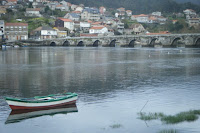 |
| Nazare Beach |
On reaching Comporta, we headed out to the resort sand spit with big beaches, scrubby sandy soil and big plantations of forestry, nothing like we have at home. This
 |
| Bill always looking for a little bit of rope! His pocket knife is a bit too litttle for this one :) |
We had wanted to stop at Lisbon (Portugal's Capital) but the parking and traffic flow compelled us forever round the sea front (like Auckland's waterfront) so that when we finally stopped we were about 40 mins away and the traffic had been so difficult and we were so fragile, it was decided to keep on going, ending up in the small town of Mafra with a secured compound to spend the night and a supermarket & laundry 5 minutes away. Admittedly not with the cultural depth of Lisbon to draw on but still with a slice history not to be trifled
 |
| Mafra Palace |
The palace has a 92 bell carillon and is immense. We considered a tour but several hours of this (over 1200 rooms & 4700 doors and windows) would undoubtedly numb us, we had a nice cafe lunch (it wasn't very summery) instead and carried on up the west coast of Portugal
 |
| Wave action on Nazare Beach |
Nazare has the distinction of a world record height for a beach breaking wave surfed at 72 feet or 23m. The You Tubes of these waves are incredible and worth a watch. The surf seems to run continually but saw photos of much quieter benign beaches which is just as well as
 |
| Old Ladies selling their dried fish along Nazare |
As we worked our way up in & out of coastal areas, we visited Aveiro, Portugal's Venice. It has, literally, a couple of canals into the town centre and is serviced by more boats than tourists at this time of year. Also in keeping with Venice it does have a large lagoon exploited traditionally for salt production and shell fish, sea food as always, a huge tourist draw. (the shellfish available is always huge from tiny pipi's and cockles up to
 |
| Trailers loaded with nets ready for the next day's fishing |
Aviero was drizzly when we arrived in the late afternoon and it didn't look pleasant sitting in boats on the canal in the driving rain, so we walked the town and by the evening's end and had a Chinese meal (sweet & sour craving) with a lovely Portuguese beer & wine. As we had seen all the canals, we decided a boat trip was not warranted.
 |
| Churches faced up with blue tiles |
On reflection if asked about favourite places we would be recommending this coastline from southern Spain up thru Portugal, back into northern Spain and now across the Bay of Biscay. These areas are worth exploring we think, not so touristy,
 |
| Walk about Arcade's village |
Onto Vigo, but decided to carry on as the weather still wasn't great, and onto Arcade. A very pleasant village at the top of another inlet port, well removed from the industrious busy river mouth and existing on a small fishing industry, mainly the local shell fish. The town centre sculpture is a large pearl in an oyster so gives a hint of the promise.
 |
| One of the many "Horreo's" we saw in backyards |
 |
| Gijion Beach across to Old Town Bit of action for the surfers in the water. |
Gijon (Hehon) was another stop, a lovely seaside surf resort. Ticks all the boxes with retail cafes and across the road enough surf to keep Dad and the boys out of trouble and did I mention the cafes! We arrived in drizzle (a recurring theme as we head north) but the next morning the mountains behind us were liberally coated in snow. Just like Nelson can have in Spring too. The north here is very hilly. The towns are all located in ancient glacial/deep river valleys giving deep long sheltered access as fitting for maritime trade etc, shelter from the Atlantic storms, woe betide if you missed the harbour though.
 |
| Wet weather doesn't put the locals off coming to the beach |
It was foolish of us to think spring would precede us, warming the Atlantic coast in preparation for such illustrious visitors such as ourselves as now on the cusp of
 |
| Looking from Gijion's promenade back to the snow covered mountains |
The juxtaposition of the two ends of the Iberian Peninsular is so pronounced, gone are the Pueblo Blanco (white washed villages) and afore mentioned cactus, palms and still flowering bougainvilleas, we are now in deciduous forests, waterlogged and a few green buds of willow bravely peeking out
 |
| Bilboa - looking down on the town |

No comments:
Post a Comment